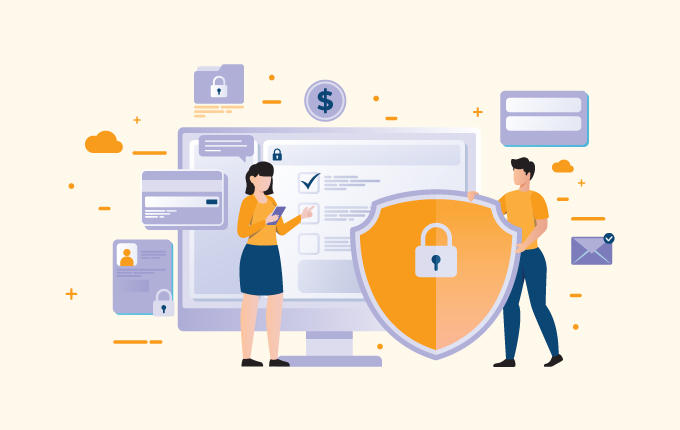Cloud ServicesIT Consulting & StrategySecurityTech Support & Managed IT ServicesFinanceConstructionEducationHealthcareLegalReal Estate
Cloud use is on the rise
Gartner reports that spend on traditional IT data centers will drop roughly 10% in 2020 to $188 billion over the previous year. Cloud spend, on the other hand, is expected to reach $81 billion in 2022, almost double what was spent in 2019.
Reports coming in from cloud service providers support these projections. Both Amazon Web Services (AWS) and Microsoft have experienced record profits in the last few years, with sales growing 44% in the case of AWS and 23% for Microsoft. With the way growth is going, it’s expected that 83% of enterprise workloads will be on the cloud by the end of 2020.

A few different factors are fueling this rise in cloud adoption.
Businesses are realizing that the cloud offers a level of flexibility that they can’t get with in-house servers. Scaling up and down is easy. You can do it on the fly as you need to add more capacity, say if you’re entering into a crunch period. And, as we saw this year with the massive shift to working from home, if things suddenly change in the workplace, you have the adaptability to let people work from wherever they need to.
Cloud computing can also be deployed faster. If you need to add to your system, it can happen in minutes instead of the long lead time you need to add bare metal servers.
Perhaps the biggest difference, though, is the cost. First of all, not having physical servers you need to maintain can regularly save you a lot of money. On top of that, you don’t need someone on-site to manage and maintain them. With the cloud, all of that is taken care of by the service provider.
Interestingly, though, despite the savings, cloud overspend is a problem many businesses deal with when they move to the cloud. As of last year, 69% of companies surveyed were overspending their cloud budget by at least 25%.
What leads to cloud overspend?
Any one issue doesn’t cause cloud overspend. It happens due to any number of a spectrum of problems that come up with provisioning and using the cloud as part of your tech stack.
Let’s take a closer look at how that happens and what you can do to prevent it.
You don’t know how to provision for the cloud
This is an easy mistake a lot of people make. They forget the cloud is instantly scalable. As a result, rather than waiting until you need to add more capacity, you order more than you’ll need for those “just in case” moments.
This happens because when you’re running physical servers, adding more server capacity takes time. You can’t just double the number of servers you’re working with one week, then scale back the next. You have to order everything weeks in advance. When you come to the cloud with the same mindset, you end up with lots of unused servers that never get used but cost you money.
You feel pressure to buy it all
Like with everything, it’s easy to get carried away with services and products you’ll never use.
Sometimes, you start looking into the cloud and realize there are many products out there that can help you be more efficient and run a better business. It’s easy to get carried away and buy too much because if some is good, more is better. But, this can result in products you don’t use and services you don’t need.
You don’t pay attention to what you’re buying
Implementing an innovative new technology can be really exciting. You get caught up in the idea of how much this is going to help your business, but you forget to really watch what you’re spending.
Because it’s so easy to add subscriptions and licenses to cloud products, adding new employees or temporary workers can be done without paying too much attention. This is great when you’re adding them, but the costs add up fast if you forget to remove them. Not only can you end up with subscriptions you don’t need, but since a lot of cloud subscriptions auto-renew, you can pay for these unnecessary licenses much longer than you need them.
Information overload
This is a common one for new cloud users. There is a TON of information out there about the cloud, what you need to be on the cloud, what the best platforms are, who the best providers are, what you need, what you don’t need… It’s easy to forget about your actual needs and just buy everything you see recommended online.
The problem here is that not only do you end up with stuff you don’t actually need, but you also lose sight of all the hidden costs associated with these services. There is so much information about the benefits of a service, how it helps, and its features that sometimes you miss the fine print.
API calls, vendor lock-in, and even premium support packages can all add to your costs if you don’t pay close attention to what you buy.
You’ve gone multi-cloud
A multi-cloud approach is gaining in popularity. Mid-size and larger companies are using an average of eight different cloud providers for the various apps and services they use. Using a multi-cloud setup isn’t bad on its own, but there are some associated costs that come with it that add up.
The highest costs are around managing a multi-cloud environment. Everything from security mitigation to reporting has to be done repeatedly over your various cloud providers. Even simple things like applying patches become time-consuming when they’re spread out over several different clouds. When you add that the scarcity of good cloud professionals, just finding someone to manage your cloud stack will be expensive.
You think the cloud is cheap
Now, we did just say that the cloud can be cheap. And it is.
The problem is that it’s also easy to lose track of how much you’re spending and where. The above points are a great example of that. There are many factors that take the cloud from a reasonable expense to something that results in tens of thousands of dollars in overspend each year.
The good news is that you can get those costs under control with the right approach and a little bit of effort.

What can you do to mitigate overspending?
Reducing cloud overspend isn’t quite as easy as wasting all that money was in the first place, but the effort you put into eliminating it can be huge.
Audit everything
This step can be a huge investment as far as time goes, but it’s going to save you a lot of money in the long run.
When you’re auditing your cloud usage, pay attention to details like the software you’re using, how many people are using each tool, and how much bandwidth you’re eating up. Auditing these will tell you if you’ve got unused software licenses, if you’re paying for instances that aren’t being used for anything, whether you’ve got tools that you use heavily during a certain part of the year but not others.
All these are areas where you’re likely to find overspend. The trick, though, is to keep auditing. You can’t just do it once and consider the problem solved. You have to set aside time to regularly look at how you’re using your cloud to make sure you’re not overspending again.
Only pay for what you use
Once you’ve conducted an audit, your usage habits should become clear. By analyzing your usage, you’ll probably discover some areas where you’re spending more than you need to be.
Things to look for include whether you’re using all the features in the plan you’ve purchased. It’s one thing to have the pro-level software suite that a company offers. But if you’re not actually using a large percentage of the tools they offer, you can probably drop down to the next level.
The same thing goes with storage. If you’ve got a lot of cloud storage space that’s just collecting digital dust, get rid of it. Even if you suddenly need more, you won’t be in trouble. Adding to the cloud is easy.
Optimize your cloud
Optimization can really streamline your cloud use and reduce spend. A lot of what you’re going to find in terms of optimization will be things we’ve already discussed in this post, but there are other, more technical aspects you can look at to really help nail down your cloud spending.
These are things like:
- Workload modeling
- Workload automation
- Rightsizing services
The goal here is to get the cloud working as smoothly as possible and get rid of anything that isn’t configured to maximize your company’s benefit.
Partner with a team of experts
One of the big problems is that people don’t have the time to really manage cloud spend within their organization. We mentioned above that there is a noticeable talent shortage in cloud services these days. The demand for experts has made it hard to find someone and, when you do find the right person, they’re not cheap.
That’s where partnering with a team of cloud experts – like us – can help. Not only can we provide you with a reliable team of experts to help you manage your cloud, but we can help cost-effectively. If you’re ready to reduce cloud overspend and fully optimize your business, let’s talk. We love helping our customers use cutting edge technology without breaking the bank.
SEE MORE
Kaytuso – the cybersecurity & regulatory compliance division of ManhattanTechSupport.com LLC.
Exceed Digital – the custom software development and business intelligence solutions division of ManhattanTechSupport.com LLC
 December 14, 2020
December 14, 2020 Manhattan Tech Support
Manhattan Tech Support




